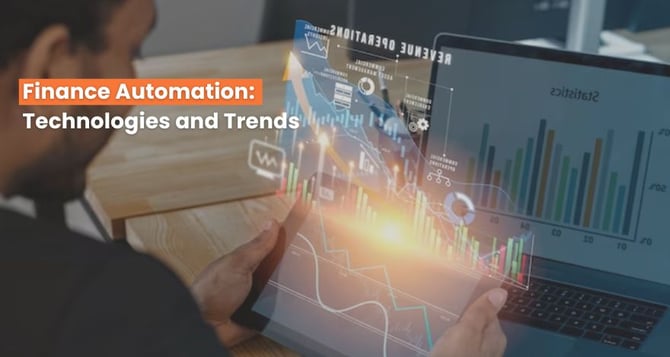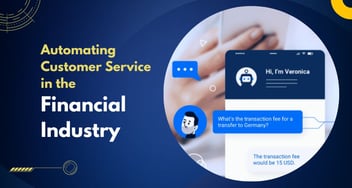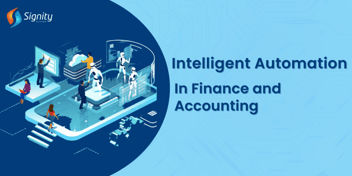The Future of Finance Automation: Emerging Technologies and Trends
Transforming finance functions from cost to value center is essential to stay ahead of the competition. Discover the most remarkable innovations in finance automation and how they shape the industry's future.

The fintech industry is in a continuous state of evolution and advancement, and this trend is set to continue in 2024. According to estimates, the revenue of the fintech industry has experienced a remarkable growth of 100% since 2017.
With 2024 being around the corner, it means working now to get the right people and technology in the right place to leverage the benefits of the inevitable disruption ahead.
In the dynamically evolving landscape of the finance world, technology is the driving force behind transformation. And the technologies required to reimagine the finance world are here and only getting better.
But, to leverage the benefits of the inevitable disruption, having the right people and technology in place is important. That's likely impossible without a clear vision and strategy for finance in a digitally dominated world.
With that in mind, let's explore the top 3 trends defining the finance industry's future in 2024 and beyond that'll help businesses and customers alike.
Exploring the Future of Finance Automation
Top 3 Predictions, Technologies, and Trends
Undoubtedly, financial processes have undergone - and continue to experience - magnificent changes, while new trends are cresting over the horizon, promising to bring more innovation ashore. But what does it bring for YOU, and how does your business benefit from it?
Organizations are already at the edge of harnessing the power of 3 disruptive trends to maximize business speed, accuracy, and efficiency:
- Artificial Intelligence and Machine Learning
- Business Ecosystem
- Finance Automation
Artificial Intelligence & Machine Language
Artificial Intelligence and Machine Learning improve financial processes with their ability to mirror offline processes of automatically notifying approvers, matching POs, and facilitating steps with minimal interactions and errors. Some businesses continually seek advanced systems in place to improve their trade operations. One remarkable emerging solution is the Trade Order Management System by Limina which allows seamless management of complex order workflows, complementing ongoing technological advancements such as Artificial Intelligence and Machine Learning.
These emerging technologies also cater your invoice data in a single view so you can identify efficiencies and areas to help your organization achieve 100% touchless Account Payable processing.
Sometimes, a major portion of the manual processes are eliminated. So, when going to the office to process AP documents manually seems daunting, this blend of technology plays a crucial role.
Moreover, in procurement, automated solutions greatly help reduce late payments to suppliers, define recurring expense payment plans, calculate accurate purchasing volumes to get discounts, and exchange financial documents and information like invoices, POs, and contracts.
This automated solution keeps the goods, services, and money flowing seamlessly.
Business Ecosystem
The future of P2P ecosystems braces a microservices architecture that allows customers to manage vendors and invest in a core spend management platform, allowing them to capitalize on the latest services offered.
So, if you dwell from finance and procurement professionals, you should adopt solutions that offer you:
- 100% automated orders and invoices
- 100% of eligible employees using e-procurement
- 100% of suppliers connected to your P2P ecosystem
Now, the one that's invisible but ubiquitous - Finance Automation!
Finance Automation
Bringing Automation to Finance
Like many others, the financial segment especially has wholeheartedly embraced automation as a reliable solution to optimize operations, save on cost, streamline processes, and manifold productivity simultaneously.
Plus, with advanced analytics, you have visibility to optimize your processes continuously and have complete access to the data to make informed business decisions and drive optimization. It provides your organization with clear data to prevent late payments, address process challenges, improve e-invoicing rates, and get hands-on early payment discounts.
With the continuously evolving financial landscape, emerging technologies and automation have become inevitable for businesses to take quantum leaps and thrive in this dynamic era. By establishing strategic approaches and embracing automation, businesses can easily ride the wave of change, turning challenges into opportunities and nurturing a prosperous future.
Here are some unskippable recommendations for automation in the financial world that you should consider.
Exploring the Power of LLM in Financial Forecasting
Coupled with advanced AI abilities, Large Language Models (LLMs) possess the potential to comprehend complicated financial information and offer other insightful recommendations by cross-referencing industry and sector-specific data. Plus, LLMs can verbalize financial tables and transform raw data into easy-to-understand narratives.
This facilitates users to access real-time analysis on the go, making results easily available to a broader audience. So, integrating LLM models into financial processes promises to streamline decision-making, improve accuracy, and democratize access to valuable insights.
Switching From RPA to CPA
A little different from conventional RPA comes CPA (Cognitive Process Automation), which goes beyond repetitive tasks, putting cognitive abilities at the forefront. So, by leveraging AI capabilities like Natural Language Processing, Machine Learning, and Data Analytics, CPA can be used to analyze financial data, make informed decisions, identify anomalies, and optimize processes.
This entrusts organizations to streamline financial operations, minimize errors, improve compliance, and get hold of valuable insights to make strategic decisions.
Optimizing Smart Contracts in Blockchain with AI
As known, smart contracts are self-executing agreements that are code written automatically executing predefined conditions on a Blockchain.
Considering this, the right blend of smart contracts and AI revolutionized the finance world by optimizing transactions and eliminating intermediaries. AI intensifies smart contract functionality through data analysis, informed decision-making, and identifying patterns, upholding efficiency, precision, and cost savings.
So, with AI-driven optimization, smart contracts revamp the financial landscape, offering protected and efficient solutions across industries and different applications.
Enhanced Semantic Automation
Semantic automation is another feather added to the hat.
This allows AI-powered bots to comprehend conversations with human-like comprehension. Armored with advanced techniques like semantic understanding and domain-specific language knowledge, the virtual AI bots can understand the context of discussions and give correct answers.
This plays a pivotal role in automating financial contracts, bills, and instructions in the economic landscape. As a result, transactions are more efficient and concise. So, by automating tasks that conventionally need human intervention, semantic automation is a godsend, enhancing user experience, optimizing financial operations, and increasing efficiency and productivity throughout the financial industry.
The Emergence of APIs
Application Programming Interfaces, popular as APIs, transform the financial aisle by allowing seamless integration, data sharing, and collaboration among different systems and services. They act as the bridge connecting different applications, allowing them to communicate and interact with each other in a standard manner.
APIs automate the exchange of information, streamline processes, and facilitate the delivery of customized financial services. By leveraging APIs, the financial domain can easily accomplish greater efficiency, enhance customer experiences, and bring innovation by allowing the development of new financial products and services.
The Belief
"Real-time finance will be a standard practice," as strategic decision-making depends on real-time data analysis rather than periodic reporting. Regardless of initial reservations, self-service will prevail within the finance sector. This evolution will create new operating models built by bots, algorithms, and diversified workforce configurations.
- According to Gartner's forecasts, over half of the population globally is expected to be a part of the Internet of Behaviors (IoB) program by 2025.
- Physical experience-based businesses will amplify financial outcomes by proliferating into paid virtual experiences.
- Deploying enterprise workloads in cloud infrastructure and platform services will witness an unprecedented surge, reaching 40% by 2023, compared to 20% in 2020.
These beliefs prove to be a strong indicator of growth in the financial world, reflecting an increased adoption rate.
Finally
In today's era of dynamically changing technologies, staying ahead of the curve requires continuous learning and upskilling, accompanied by thriving in an ever-evolving landscape.
Especially for businesses, embracing automation is unskippable to stay the trailblazer of innovation. For companies, harnessing the power of cutting-edge tools like Intelligent Document Processing, Cognitive Automation, and Conversational AI is unskippable. Additionally, picking up agile methodologies like DevOps allows quick adaptation to changing market dynamics.
Ready to be the next big? Leverage the right tools, methodologies, and strategies with experts to seize the opportunities presented by the future of financial automation, driving greater productivity and growth.













